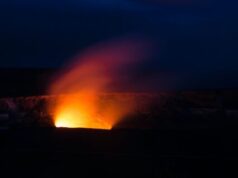Researchers have shown that over the past two thousand years, volcanoes have played a larger role in natural temperature variability than previously thought, and their climatic effects may have contributed to past societal and economic change.
The researchers, led by the University of Cambridge, used samples from more than 9000 living and dead trees to obtain a precise yearly record of summer temperatures in North America and Eurasia, dating back to the year 1 CE. This revealed colder and warmer periods that they then compared with records for very large volcanic eruptions as well as major historical events.
Crucial to the accuracy of the dataset was the use of the same number of data points across the entire 2000 years. Previous reconstructions of climate over this extended period have been biased by over-representation of trees from more recent times.
The results, reported in the journal Dendrochronologia, show that the effect of volcanoes on global temperature changes is even greater than had been recognised, although the researchers stress that their work in no way diminishes the significance of human-caused climate change.
Instead, the researchers say, the study contributes to our understanding of the natural causes and societal consequences of summer temperature changes over the past two thousand years.
Find your dream job in the space industry. Check our Space Job Board »
“There is so much we can determine about past climate conditions from the information in tree rings, but we have far more information from newer trees than we do for trees which lived a thousand years or more ago,” said Professor Ulf Büntgen from Cambridge’s Department of Geography, the study’s lead author. “Removing some of the data from the more recent past levels the playing field for the whole 2000-year period we’re looking at, so in the end, we gain a more accurate understanding of natural versus anthropogenic climate change.”
Comparing the data from tree rings against evidence from ice cores, the researchers were able to identify the effect of past volcanic eruptions on summer temperatures.
Large volcanic eruptions can lower global average temperatures by fractions of a degree Celsius, with strongest effects in parts of North America and Eurasia. The main factor is the amount of sulphur emitted during the eruption that reaches the stratosphere, where it forms minute particles that block some sunlight from reaching the surface. This can result in shorter growing seasons and cooler temperatures, that lead in turn to reduced harvests. Conversely, in periods when fewer large eruptions occurred, the Earth is able to absorb more heat from the Sun and temperatures rise.
“Some climate models assume that the effect of volcanoes is punctuated and short,” said Büntgen. “However, if you look at the cumulative effect over a whole century, this effect can be much longer. In part, we can explain warm conditions during the 3rd, 10th and 11th centuries through a comparative lack of eruptions.”
Reconstructed summer temperatures in the 280s, 990s and 1020s, when volcanic forcing was low, were comparable to modern conditions until 2010.
Compared with existing large-scale temperature reconstructions of the past 1200-2000 years, the study reveals a greater pre-industrial summer temperature variability, including strong evidence for the Late Antique Little Ice Age (LALIA) in the 6th and 7th centuries.
Then, working with historians, the scientists found that relatively constant warmth during Roman and medieval periods, when large volcanic eruptions were less frequent, often coincided with societal prosperity and political stability in Europe and China. However, the periods characterised by more prolific volcanism often coincided with times of conflict and economic decline.
“Interpreting history is always challenging,” said Dr. Clive Oppenheimer, the lead volcanologist of the study. “So many factors come into play—politics, economics, culture. But a big eruption that leads to widespread declines in grain production can hurt millions of people. Hunger can lead to famine, disease, conflict and migration. We see much evidence of this in the historical record.
“We knew that large eruptions could have these effects, especially when societies were already stressed, but I was surprised to see the opposite effect so clearly in our data—that centuries with rather few eruptions had warmer summers than the long-term average.”
The new temperature reconstructions provide deeper insights into historical periods in which climactic changes, and their associated environmental responses, have had an outsized impact on human history. This has clear implications for our present and future. As climate change accelerates, extreme events, such as floods, drought, storms and wildfires, will become more frequent.
“Humans have no effect on whether or not a volcano erupts, but the warming trend we are seeing right now is certainly related to human activity,” said Büntgen. “While nothing about the future is certain, we would do well to learn how climate change has affected human civilisation in the past.”
Provided by: University of Cambridge
More information: Ulf Büntgen et al. Prominent role of volcanism in Common Era climate variability and human history. Dendrochronologia (2020). DOI: 10.1016/j.dendro.2020.125757
Image: Driftwood in Siberia.
Credit: University of Cambridge











